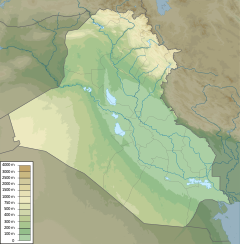Mosque-Madrasa of al-Asifyah
| Mosque-Madrasa of Al-Asifyah | |
|---|---|
 | |
| Religion | |
| Affiliation | Islam |
| Ecclesiastical or organisational status | Mosque and madrasa |
| Status | Active |
| Location | |
| Location | Tigris riverbank, Baghdad, Iraq |
Location in Iraq | |
| Geographic coordinates | 33°20′20″N 44°23′21″E / 33.3389°N 44.3892°E |
| Architecture | |
| Style | |
| Creator | Dawud Pasha |
| Date established | 1608 |
| Specifications | |
| Capacity | 500 worshipers |
| Interior area | 400 square metres (4,300 sq ft) |
| Dome(s) | 2 |
| Minaret(s) | 2 |
| Shrine(s) | 1 (identity disputed) |
The Mosque-Madrasa of al-Asifyah (Arabic: مدرسة الآصفية) is a complex of mosque and madrasa located near the riverbank of Tigris, in Baghdad, Iraq. The mosque and its associated complex including school buildings, old courts and other former government buildings, and a palace are contained within a 7.57-hectare (18.7-acre) site alongside the banks of the Tigris that forms part of a tentative UNESCO World Heritage Site list.[1]
The mosque complex also includes a small shrine, which is believed to entomb the remains of Islamic scholar al-Kulayni.[2] It could also contain the tomb of Islamic Sufi Imam al-Muhasibi.[3]
Etymology
[edit]The Arabic name of the complex, al-Asifyah (الآصفية) is deprived from the laqab of Mamluk governor of Baghdad Dawud Pasha, the governor that renovated the complex. Who used to name himself Asif al-Zaman (آصف الزمان, 'The Portrait of Time').[4]
Historical background
[edit]Background and founding
[edit]The way the tomb was built indicates that the shrine was originally supposed to be a tomb of one of the Abbasid Caliphs. As the area where the complex was built used to be a cemetery for Banu Abbas, as mentioned by some historians. It was uncommon for Abbasid caliphs to spend about ten thousand dinars on the building of a shrine similar to this one and people at that time never decorated graves sites in respect to the traditions of Muhammad, so it is possible that this was originally an Abbasid tomb. The mosque was one of the facilities and accessories of the madrasa, so it is possible that the builder of the aforementioned madrasa would be buried in it.[5]

The complex originally consisted of a mosque, Sufi lodge named "Dar al-Qu'ran" and khan, and was called Mawla-Khana in lineage to Darwish Mawlai who established the two institutions. In 1590, the Sufi lodge itself would be built by Cığalazade Yusuf Sinan Pasha, who ruled Baghdad from 1590 to 1594. The complex itself would later become the building ground for al-Asifyah Mosque much later.[6] The Madrasa, which existed before the Sufi lodge, was also considered a subordinate of al-Mustansiriya Madrasa, which was located next to it.[3]

Later the building that belonged to the original complex was eroded and had to be demolished. The complex was then taken over by one of the students of the lodge who belonged to the Sufi tariqa, until the building was renovated by Muhammad Jalabi Khatib al-Diwani in 1596. It then became the facility of al-Mustansiriyya Madrasa. The building was renovated again by the ruler Mamluk of Baghdad Dawud Pasha in its current appearance in 1825.[1] During the time, two madrasas were built for elementary and secondary levels, attached with preaching area and a minaret. He also reformed the mosque with larger prayer space, and erected two minarets to the south of the mosque made of stone and decorated with Qashani tiles. The buildings were engraved with the poetry by Sheikh Saleh al-Tamimi.[7]
Later events
[edit]Among the sheikhs who taught in the complex was Sheikh Ali bin Hussein al-Kuti, who died in 1917, and the last teacher in the madrasa was Sheikh Abd el-Jalil bin Ahmed al-Jamil, who died in 1957. Teaching in the madrasa was canceled after his passing, and the archaeological library of the complex was transferred to the Public Endowments Library located in Bab al-Mu'atham in Baghdad.[7]
Architecture
[edit]
The minaret of the mosque is well known for having two balconies, each having muqarnas below them. The minaret is decorated with Qashani tiles and several decorations. Adjacent to the minaret are two large domes above the main prayer hall.[8]
Burials
[edit]- Muhammad ibn Ya'qub Ishaq Al-Kulayni: A notable Shi'i Muslim scholar.
- Al-Harith al-Muhasibi: Sufi Muslim theologian, philosopher and ascetic.
See also
[edit]References
[edit]- ^ a b "Historical Features of the Tigris River in Baghdad Rusafa, which extends from the school Al-Mustansiriya to the Abbasid Palace". Tentative Lists: World Heritage Site. UNESCO. Retrieved January 3, 2018.
- ^ "Lessons from the Lives of our Ulema – Part 9". www.islamic-laws.com. Retrieved 2022-05-22.
- ^ a b Al-Kilani, Ma'id Sharaf al-Din (13 January 2015). The old Madrasas of Iraq 941-1336 AH/1534-1917 AD (in Arabic). Dar al-Kutub al-Ilmiyah. p. 61. ISBN 9782745184030.
- ^ Al-Kilani, Mi'ad Sharaf al-Din; Al-Umari, Yassin (5 April 2013). The History of the Beauties of Baghdad: It is a refinement of the ultimate goal (in Arabic) (1st ed.). Beirut: Dār al-Kutub al-ʻIlmīyah. p. 267. ISBN 9782745177971. OCLC 1137081516.
- ^ Al-Alusi, Muhammad Shukri (1927). History of Baghdad Mosques and Monuments. Dar al-Salam Printing Press.
- ^ Francis 2017, p. 235.
- ^ a b Al-Durabi, Ibrahim (1958). Baghdadis, their news, and councils (in Arabic). Baghdad: Al-Rabita Press. p. 275.
- ^ Francis 2017, p. 236.
Works cited
[edit]- Francis, Bashir Youssef (10 July 2017). Encyclopedia of Cities and Sites in Iraq (in Arabic). Vol. 1. E-Kutub Ltd. ISBN 9781780582627.

